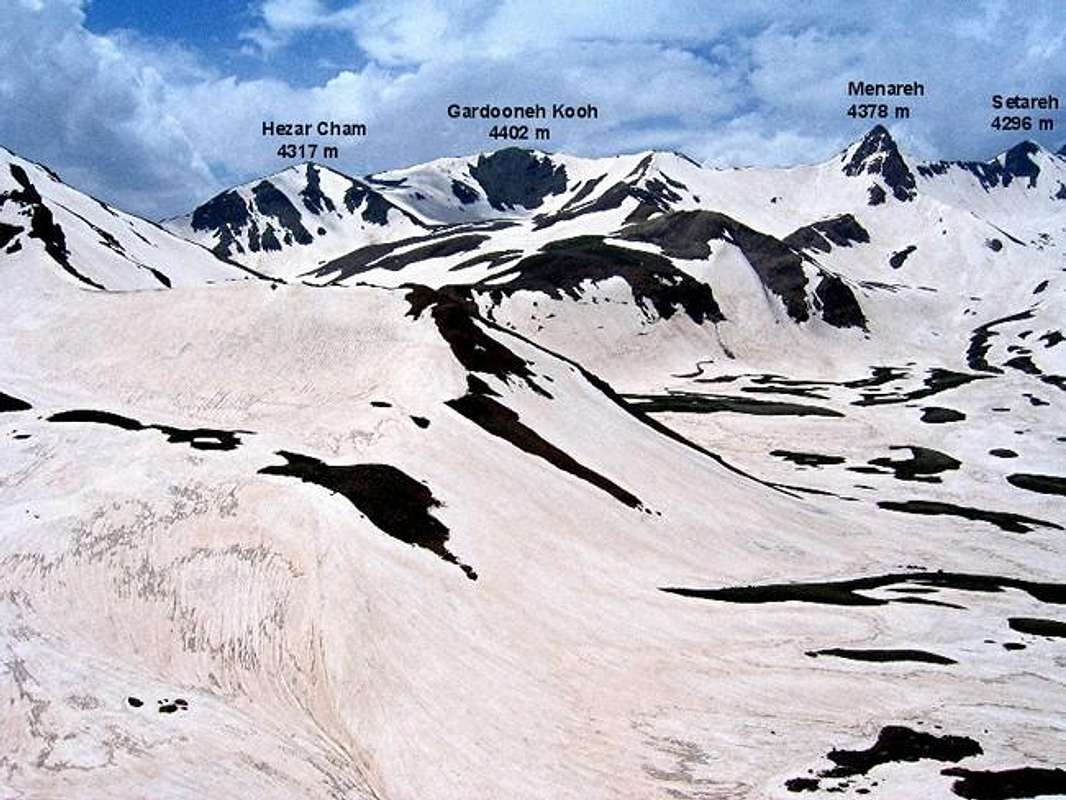|
|
Mountain/Rock |
|---|---|
|
|
36.34410°N / 50.95880°E |
|
|
14442 ft / 4402 m |
|
|
Overview
NOTES:Click for Introduction to Takhte Soleyman Massif.
Click for a map of Central Alborz.
Click for a map of Takhte Soleyman Massif.
Click for an aerial photo of Takhte Soleyman Massif.
My GPS/altimeter showed the elevation of this peak to be 14460 ft (4407 m). The 4402 m figure is per the 1:50 000 map mentioned below.


OVERVIEW:
The highest peak in the southern 1/3rd of the Takhte Soleyman Massif (The southern 1/3rd can be defined as the area south of the South Khersan Peak).
"Hesar Chal" is a roughly circular plain with an approximate diameter of 1.5 km (one mile) in the southern third of the Takhte Soleyman Massif. It is gently sloped, drains to the east and is 3600-4000 m (11800-13100 ft) high. To the north, Hesar Chal leads to the valleys of Khersan and Marji Kesh Glaciers. The main spine of the Takhte Soleyman Massif forms a continuous line of peaks to the west and south of Hesar Chal. Gardooneh Kooh is the highest of these peaks. Unlike the jagged peaks that surround Alam Kooh in the central portion of the massif, the southern peaks are gentle and are easy to climb (except for the rocky horn that forms the summit of the Menareh Peak).
A minimum of three days is usually needed to climb Gardooneh Kooh (see Route). The starting point is the village of Roodbarak (elevation 1400 m, 4700 ft). From Roodbarak, you will hike up the valley of Sardab Rood River to Hesar Chal. This hike will take you past beautiful meadows that in early summer are covered with wild flowers. Snowy peaks provide dramatic backgrounds for these meadows (PIC1, PIC2, PIC3, PIC4). Just below Hesar Chal, the valley becomes narrow. This area is known as "Tange Galoo" (literally translates as "Throat Narrows"). Frequent winter avalanches create huge piles of snow that remain here year round (PIC!, PIC2).
Hesar Chal is an ideal place for overnight camping because it can provide quick access to many of the nearby peaks including Alam Kooh. When we were in Hesar Chal in late June, most of it was still covered with snow. By mid summer, flowers and grasses come to replace the snow. The eastern slopes of Gardooneh Kooh rise directly above Hesar Chal and give easy access to its summit. From the summit of Gardooneh Kooh you will have great views of the southern slopes of Alam Kooh and the other jagged peaks that surround the Khersan Glacier. To the east, west and south, you will find other nearby peaks of Central Alborz outside of the Takhte Soleyman Massif. The very long northwestern ridge of Gardooneh Kooh drops 900 m (3000 ft) into the upper portions of the Garma Rood (Sehezar) Valley.
Getting There
See Map.From downtown Tehran drive 40 km west to the town of Karaj and take the Karaj-Chalus Road north (This road crosses the Alborz Mountains taking you through the Kandovan Tunnel to the Caspian Coast). 30 km south of Chalus, you will reach the town of Marzan Abad. Turn left and follow a side road into the Sardab Rood River drainage and to the town of Roodbarak. Distance from Tehran to Roodbarak is roughly 200 km (125 miles)

Red Tape
I am not aware of any permit or fee requirement. Hunting will require a license.When To Climb
June to October is the ideal season. Climbing in winter will obviously be much harder due to extreme cold and heavy snow cover.Camping
Accommodations are available at the Iran Mountaineering Federation Hotel in Roodbarak (call Mountaineering Federation at 98 21 8839928) or camp anywhere.Mountain Conditions
In summer, the weather is generally clear. Unexpected thunderstorms do occur frequently. Precipitation at higher elevations will almost always be in the form of snow/hail.
Miscellaneous Info
TOURS/GUIDES:If you are not familiar with these mountains, you will greatly benefit from the presence of a guide. I worked with Araz Adventure Tours and was very satisfied with their services. They were flexible, courteous and knowledgeable and were able to custom design an 8 day trekking tour allowing me to climb the lesser known peaks of the area. My guide: Mr. Rasool Naghavi was a kind man who was a native of Roodbarak and knew the mountains like the back of his hand. Having climbed Everest and several other Himalayan giants made him, in my opinion, one of the most qualified guides for these mountains.
MAPS:
1) The most accurate topographical maps of the area are those with a scale of 1:50 000 (contour lines of 20 m) provided by the Iranian Armed Forces. You will need sheet #6162 I "Shahrestanak" for Gardooneh Kooh and Alam Kooh (To fully cover the entire Takhte Soleyman Massif, you will also need sheet #6262 IV "Rudbarak"). These maps are available in Tehran at the Geographical Office of the Armed Forces on Moalem St. (98 21 8408088) for the equivalent of $3 per sheet (in 2004). Outside of Iran, the same maps can be purchased at www.cartographic.com for the exorbitant price of $150 per sheet (in 2003). These maps are in Farsi. While they give the exact elevation of most of the peaks, they do not give the names of the individual peaks.
2) Soviet Military Maps sheet # J-39-126-G available at www.omnimap.com. I do not recommend this map. It seems as if the creators of this map lacked detailed info and eliminated many of the lower peaks.
3) Different schematic maps available in Iran. My favorite is the "Guide Map of Takht-e-Soleiman & Alam Kuh Region" by Iran Kuhro Co. available at Varzesh Kooh store, Ferdowsi Sq., Tehran (98 21 8826642).


















